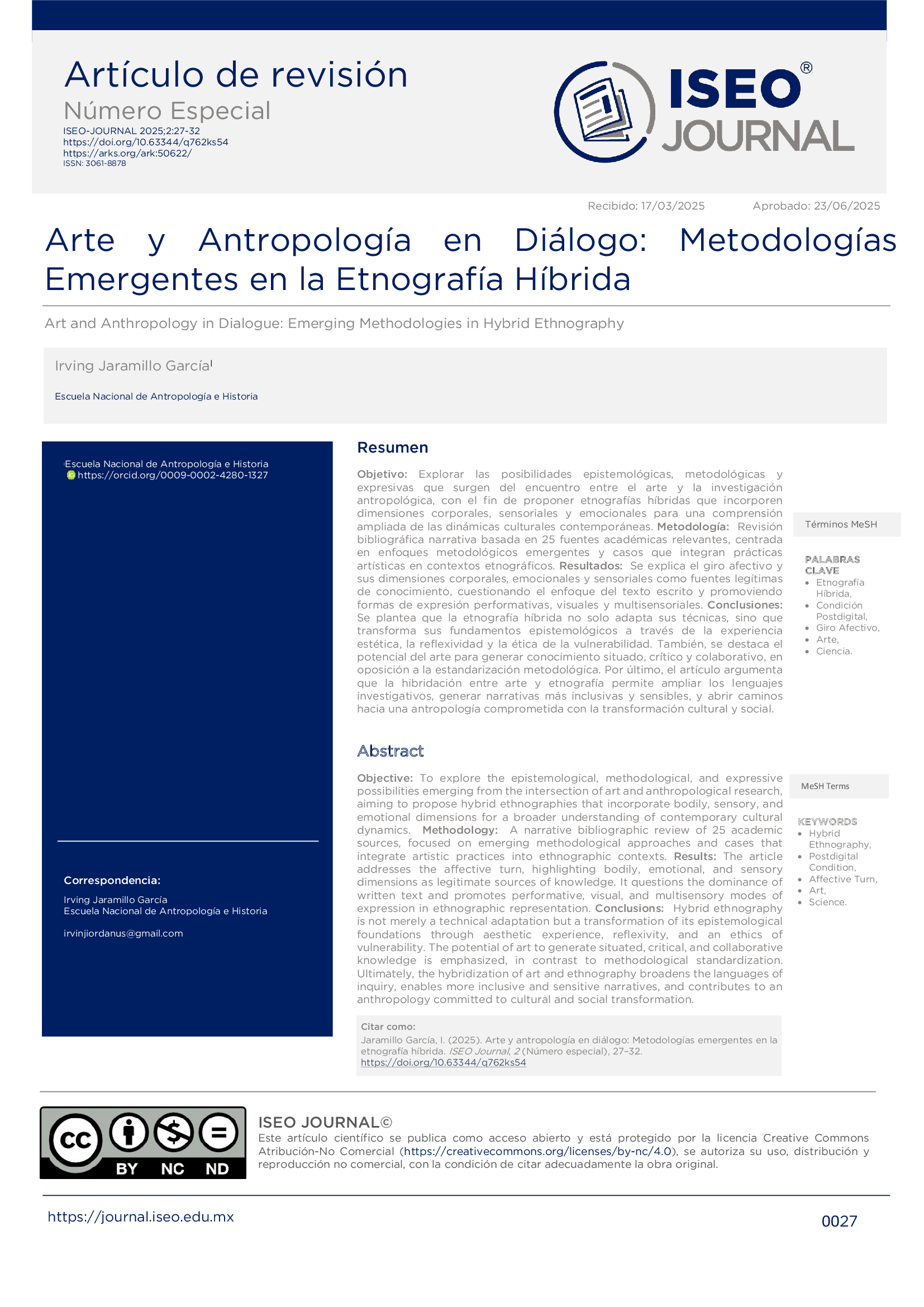
Published 2025-07-31
Keywords
- Hybrid Ethnography,
- Postdigital Condition,
- Affective Turn,
- Art,
- Science

This work is licensed under a Creative Commons Attribution-NonCommercial-NoDerivatives 4.0 International License.
How to Cite
Abstract
Objective: To explore the epistemological, methodological, and expressive possibilities emerging from the intersection of art and anthropological research, aiming to propose hybrid ethnographies that incorporate bodily, sensory, and emotional dimensions for a broader understanding of contemporary cultural dynamics. Method: A narrative bibliographic review of 25 academic sources, focused on emerging methodological approaches and cases that integrate artistic practices into ethnographic contexts. Results: The article addresses the affective turn, highlighting bodily, emotional, and sensory dimensions as legitimate sources of knowledge. It questions the dominance of written text and promotes performative, visual, and multisensory modes of expression in ethnographic representation. Conclusions: Hybrid ethnography is not merely a technical adaptation but a transformation of its epistemological foundations through aesthetic experience, reflexivity, and an ethics of vulnerability. The potential of art to generate situated, critical, and collaborative knowledge is emphasized, in contrast to methodological standardization. Ultimately, the hybridization of art and ethnography broadens the languages of inquiry, enables more inclusive and sensitive narratives, and contributes to an anthropology committed to cultural and social transformation.
Downloads
References
- Aristóteles. (1974). Poética. Gredos.
- Alcadipani, R., & Cunliffe, A. L. (2023). The shifting nature of relationality in the blurred boundaries of hybrid organizational ethnography. British Journal of Management, 35(2), 679–691. https://doi.org/10.1111/1467-8551.12728
- Álvarez Pedrosian, E. (2018). Sentidos de lo experimental en la etnografía contemporánea. Un debate epistemológico. Antropología Experimental, 18. https://doi.org/10.17561/rae.v0i18.3531
- Arfuch, L. (2016). El “giro afectivo”. Emociones, subjetividad y política. Dialnet. https://dialnet.unirioja.es/servlet/articulo?codigo=6181109
- Cortés Picazo, L., & Grinspun Siguelnitzky, N. (2019). La importancia del cuerpo en las prácticas pedagógicas en Artes Visuales. Perspectiva Educacional, 58(3), 102–126. https://dx.doi.org/10.4151/07189729-vol.58-iss.3-art.865
- Cortés Picazo, L., & Grinspun Siguelnitzky, N. (2023). Percepción de la corporeización de las emociones, según profesores/as que imparten la asignatura de Artes Visuales en Santiago de Chile. Revista De Estudios Y Experiencias En Educación, 22(48), 65–83. https://doi.org/10.21703/0718-5162.v22.n48.2023.004
- Cruz Picón, P. E. (2024). La relevancia de la antropología en el pensamiento de Ingold. [Reseña del libro Antropología: por qué importa]. Investigación & Desarrollo, 32(2), 357–364. https://doi.org/10.14482/indes.32.02.338.753
- Decuypere, M., Brandau, N., Hartong, S., Joecks, L., Ortegon, C., Loft-Akhoondi, A., Tierens, T., & Vanermen, L. (2025). Tracing the infrastructural unfolding of (edtech) events through hybrid team ethnography. Learning Media and Technology, 1–15. https://doi.org/10.1080/17439884.2025.2458667
- García Barreno, P. R. (2019). Introducción [Ponencia]. II Encuentro “Ciencia – Arte – Creatividad”, Fundación Botín & UIMP, Centro Botín, Santander, España. https://fundacionbotin.org/…/1PedroGarciaBarrenoIntroduccion.pdf
- Gherardi, S. (2018). Theorizing affective ethnography for organization studies. Organization, 26(6), 741–760. https://doi.org/10.1177/1350508418805285
- Gowey, D. (2018). Headhunting, slave raiding, and shape shifting: Modes of prowess in an early modern Visayan society [Ponencia]. Association of Asian Studies Annual Conference, Washington, DC. https://www.academia.edu/36280037/ Headhunting_Slave_raiding_and_Shape_shifting_Modes_of_Prowess _in_an_Early_Modern_Visayan_Society
- Igartua Huarte, I. (1997). Dostoievski en Bajtín: raíces y límites de la polifonía. Epos: Revista de filología, (13), 221. https://doi.org/10.5944/epos.13.1997.10018
- Ingold, T. (2016). Conociendo desde dentro: reconfigurando las relaciones entre la antropología y la etnografía. Etnografías Contemporáneas, 2(2). https://revistasacademicas.unsam.edu.ar/ index.php/etnocontemp/article/view/410
- Jandrić, P., Knox, J., Besley, T., Ryberg, T., Suoranta, J., & Hayes, S. (2018). Postdigital science and education. Educational Philosophy and Theory, 50(10), 893–899. https://doi.org/10.1080/00131857.2018.1454000
- Lozoya, J. (2018). Giro afectivo: una aproximación al dilema espacial de las emociones. Bitácora Arquitectura, (39), 34–39. https://doi.org/10.22201/fa.14058901p.2018.39.67825
- Perdomo Marín, J. C. (2019). Anthropology and/as Education Tim Ingold. Nueva York: Routledge 2018, 107 páginas. Revista Colombiana de Antropología, 55(2), 194–199. https://www.redalyc.org/comocitar.oa?id=105060353008
- Pink, S. (2015). Doing sensory ethnography (2.ª ed.). Sage Publications Ltd. https://methods.sagepub.com/book/mono/doing-sensory-ethnography-2e/toc
- Porto, N. (2015). Arte e etnografia cokwe: antes e depois de Marie-Louise Bastin. Etnografica, 19(1), 139–168. https://doi.org/10.4000/etnografica.3941
- Restrepo, E. (2018). Etnografía: alcances, técnicas y éticas. Universidad Nacional Mayor de San Marcos. https://www.aacademica.org/eduardo.restrepo/3.pdf
- Sabrina Belén, P. (2019). Arte y conocimiento. La dimensión epistémica del proceso artístico en la contemporaneidad. Revista Humanidades, 9(2), 1–16. https://doi.org/10.15517/h.v9i2.37126
- Sánchez Beltrán, Z. (2017). Investigación en educación artística: Más allá de los riesgos, la búsqueda por las posibilidades. Pensamiento, palabra y obra, (18), 87–100. https://dialnet.unirioja.es/servlet/articulo?codigo=6244349
- Schulte-Römer, N., & Gesing, F. (2022). Online, offline, hybrid: Methodological reflection on event ethnography in (post-)pandemic times. Qualitative Research, 23(6), 1620–1646. https://doi.org/10.1177/14687941221110172
- Serón Torrecilla, F. J. (2019). Arte, ciencia, tecnología y sociedad. Un enfoque para la enseñanza y el aprendizaje de las ciencias en un contexto artístico. Revista Iberoamericana De Ciencia, Tecnología Y Sociedad - CTS, 14(40). https://ojs.revistacts.net/index.php/CTS/article/view/99
- Stalder, F. (2021). Was ist Digitalität? In Digitalitätsforschung (pp. 3–7). https://doi.org/10.1007/978-3-662-62989-5_1
- Stoller, P. (2021). El arte de la etnografía en tiempos turbulentos. AIBR. Revista de Antropología Iberoamericana, 16(1), 11–20. https://recyt.fecyt.es/index.php/AIBR/article/view/89880
- Zambrano, M. (2016). La investigación en el arte –la relación arte y ciencia, una introducción. Index Revista De Arte Contemporáneo, 1, 110–116. https://doi.org/10.26807/cav.v0i01.25

